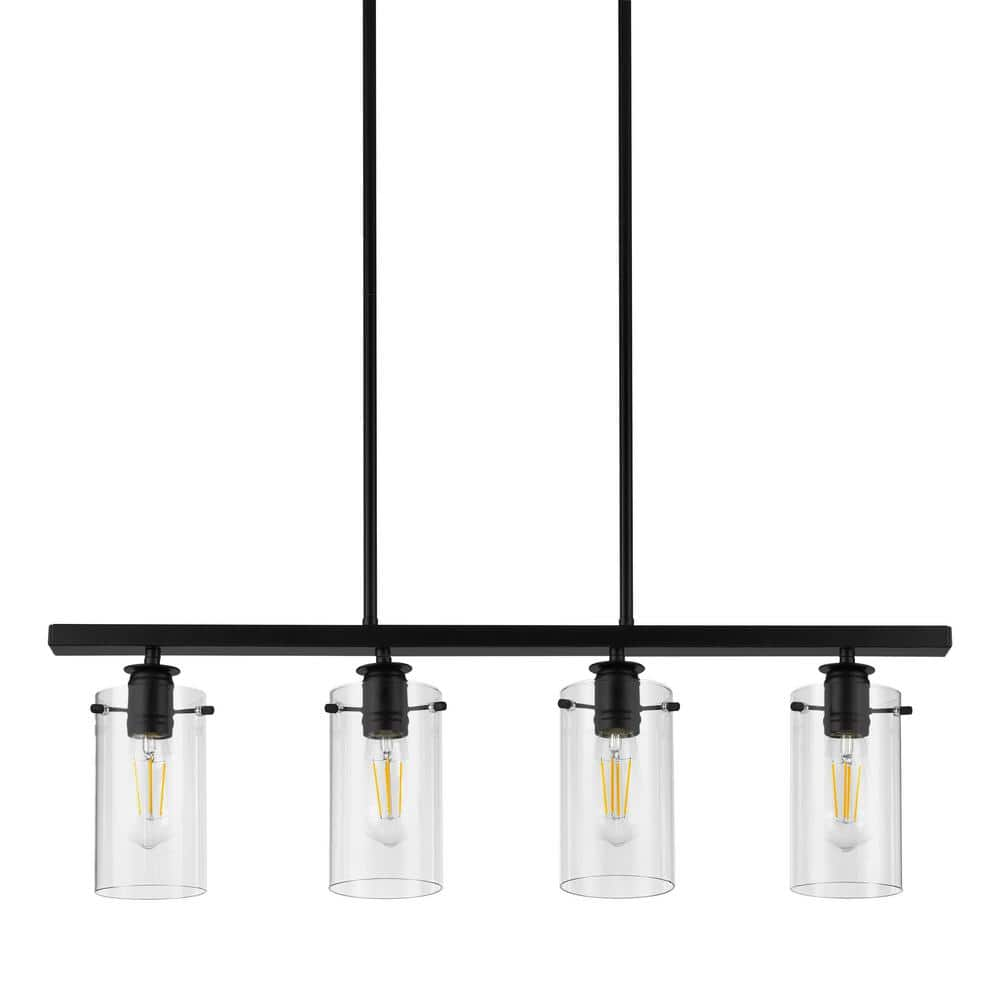Hampton Bay Regan 4-Light Matte Black Island Chandelier with Clear Glass Shades, Industrial Linear Kitchen Pendant Light
Features industrial style design with a matte black finish. Uses four 60-watt vintage style bulbs, sold separately. Linear shape is ideal above kitchen island or dining room table.
Enhance your home interior with this Hampton Bay Regan 4-light island chandelier. Great for your dining room or kitchen, the clear cylinder glass shades and matte black finish create decorative charm. This adjustable, dimmable fixture comes with all mounting hardware for a convenient installation. Steel construction ensures lasting use.
- Matte black finish
- Product dimensions: 31.25 in. W x 4.75 in. D x 9.25 in. H (does not include length of hanging rod)
- Maximum hanging length: 46.75 in. L
- Canopy shape: rectangular
- Cylindrical clear glass shades
- Canopy dimensions: 1 in. D x 12.6 in. W x 4.75 in. H
- Hanging mechanism: rod
- Uses (4) 60-watt vintage Edison bulbs or LED equivalent or standard bulbs (sold separately and depending on the look you desire)
- Dimmable (if bulbs installed support dimming)
Additional information
| Chain Length (in.) | 46.75 |
|---|---|
| Fixture Depth (in.) | 4.75 |
| Fixture Height (in.) | 9.25 |
| Fixture Weight (lb.) | 8.2 |
| Fixture Width (in.) | 31.25 |
| Maximum Hanging Length (in.) | 46.75 |
| Mounting Deck Height (in.) | 4.75 |
| Mounting Deck Width (in.) | 12.6 |
| Certifications and Listings | ETL Listed |
| Manufacturer Warranty | 3 Years |






by Indy
The light fixture looks nice and was fairly easy to install with the exception of the final stage of installing the glass globes – the screws which hold the glass were not perfectly aligned – specifically some of the screws would not fit the holes where they needed to turn to support. Luckily there were 2 spare screws which worked-so all is good. Remember to buy your light bulbs because they are not included.
by Nomie
It looks great in my kitchen and gives the look i was going for but its not quite symetrical but not very noticeable ao it doesn’t bother me anymore. Nobody else ever noticed it.
by Tallulah
It looks beautiful in my dining area. The person who installed it liked it so much he’s buying one for his home. He said it was easy to install. I use a dimmer switch and regular bulbs and it gives off the perfect amount of light for us.
by Mendo
I have tall ceilings where I live and the hideous builder quality ceiling huggers had to go. Since it’s a log home I wanted fixtures that wouldn’t stand out too much. The simplicity of this light is just what I wanted over the entry. The lenses are almost invisible when the light is not on but offer a pleasing glow when the light is on. I used compact LED reflector bulbs to direct the light down. I find that Edison style bulbs light up the ceiling and because there is so much ceiling the room tends to look like, a Home Depot. The package comes with 3 down rods so depending on how many you use, you can bring the light down about 3 feet from the ceiling. This could be great for very very tall ceilings or over a dining table. Installation was easy but one of the nuts was stripped. I would still recommend this light, just don’t wait as long to install it as I did.
by Sparky
Perfect for my spot!